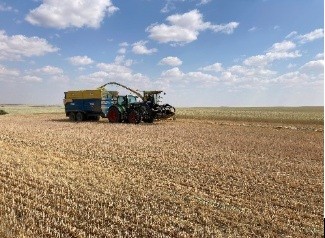Silage is one way to preserve harvested forage for use throughout the rest of the year. The underlying principle of making silage is allowing bacteria to multiply and produce acid – specifically acetic acid.
Staging the crop is the starting point for making quality silage. Depending on the crop being ensiled, and the intended use, the optimum stage may be slightly different. Ensiling alfalfa for dairy production is often cut at the late vegetative to early bloom stage while for feeding beef animals it will be cut closer to full bloom. Cereal grains are often silaged at the mid to late dough stage to capture as much energy yield as possible.
Once the decision has been made to start cutting the crop, the next factor is deciding how long to let the crop wilt or how much moisture it needs to lose before it is chopped. Depending on the storage system or structure being used the optimum moisture content does shift but the target moisture level for most cereal crops would fall in the 63% plus or minus 5% moisture.
Theoretical length of cut can be adjusted by mechanical means. Shorter cut length translated into more surface area for the bacteria to access, but it typically comes at the cost of greater fuel consumption. Older machines required changing sprockets and altering cutterhead knife configurations while newer machines can adjust the cut length with the press of a button in the cab. For cool season crops, the target cut length will be 10 millimeters or 3/8 of an inch, while for corn silage the cut length is closer to 20 mm or ¾ of an inch. Keeping knives sharp and the shear bar adjusted correctly keeps the forage harvester running efficiently and the desired cut length is more likely to be achieved.
Removing as much air as possible is a critical step in process. Upright silos rely on the weight of the material above to press down on the forage below. In silage pits and silage piles, the forage is spread in thin layers and the air is squished out by driving a heavy object like a tractor over it repeatedly. The goal is to eliminate as much oxygen as possible from the pile to favor the anaerobic fermentation process and minimize spoilage. A well packed pile can be walked on without sinking more than an inch into the surface. Once the silo has been filled, preventing air and moisture entry into the pile or pit is accomplished by covering with a thick plastic sheet and sealing the edges. Additional air and gas that forms during the ensiling process can be removed using a vacuum – a grain vac can get the job done in a hurry but a shop vac that is allowed to run for a while can get the job done too.
Silage season is an exciting time of year. Preserving a large quantity of feed in a short period of time requires several pieces of equipment moving in a synchronized effort.
For additional information on making silage contact the Agriculture Knowledge Centre at 1-866-457-2377.
